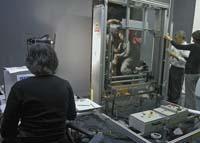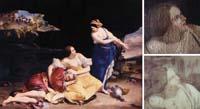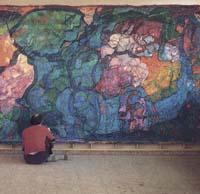2008/11/01
247. zenbakia

eu es fr en cat gl
Aparecerá un contenido traducido automáticamente. ¿Deseas continuar?
Un contenu traduit automatiquement apparaîtra. Voulez-vous continuer?
An automatically translated content item will be displayed. Do you want to continue?
Apareixerà un contingut traduït automàticament. Vols continuar?
Aparecerá un contido traducido automaticamente. ¿Desexas continuar?
Untouched, at the bottom of the works
Text created by automatic translator Elia and has not been subsequently revised by translators.
Elia Elhuyar
What we want is that the works of art of yesteryear can be preserved as in the day they were made. In general, we want to see the work as the author left it at the time of his visit to a museum. For this, logically, the smaller the intervention, the better. That is, if non-destructive techniques are used for study, restoration and conservation, better.
Untouched, at the bottom of the works
01/11/2008 | Kortabitarte Egiguren, Irati | Elhuyar Zientzia Komunikazioa

(Photo: Bilbao Museum of Fine Arts)
As the name suggests, non-destructive techniques do not deteriorate the work of art and are widely used in museums for the study, restoration and conservation of works of art. To check this, we visited the Museum of Fine Arts in Bilbao, with the María José Ruiz-Ozaita Conservation and Restoration technique. "Non-destructive techniques are based on research conducted without contact with the sample, using both visible and invisible radiation," says Ruiz-Ozaita.
Playing with the light
In the field of visible light, photography can be one of the most common techniques for the scientific study of works of art and is very useful. In general, the photography techniques used are black and white photographs and color photographs made through incident light and photographs taken through scratching light and emitted light.
The use of rasante light is the arrangement of the light focus on the same plane of the object. Thus, light illuminates all elements located outside the plane and provides a certain map of information of all the layers that make up the work.

María José Ruiz-Ozaita, who works with non-destructive techniques at the Bilbao Museum of Fine Arts.
I. Kortabitarte
"In the case of emitted light, the light bulbs are placed on the back of the work and we collect the image that informs us of the surface paintings," says Ruiz-Ozaita. This provides a lot of information. In fact, this light can also largely cross translucent objects, cracks, abrasions, lost parts or opaque objects with transparent parts. Reports on possible craquelates and/or elevations in different areas, as well as possible tensions and interactions between different materials. In this way we can analyze, among other things, how he has done the work.
In addition, to know the details of the work is used macrophotography and microphotography. The difference between the two lies in the increase in the image. In macrophotography you can get the real image to increase ten times. This allows an observation of details of specific interest, an analysis of the state of the art and of the materials and a certain control of the effectiveness of the treatments.
In microphotography, higher increases are achieved than in macrophotography. After all, one and the other reveal the structure of the paintings at macroscopic and microscopic level.

Macrofoto (right above) and microfoto (right below) from Francisco Iturrino's Xalak painting. Both give an account of the structure of the paintings in different extensions.
(Photo: Bilbao Museum of Fine Arts)
Invisible
Outside the visible spectrum, ultraviolet, infrared and X-ray light are also used to preserve artistic heritage. "To illuminate the work with ultraviolet light we use the Wood lamp, lighting that produces a fluorescence of eleven tones on the surface of the object. We analyze those tones," says Ruiz-Ozaita. "These tones give us information especially about varnishes and we see them as dark spots. After all, these spots tell us about the retouching of the work over the years." These tweaks are used to slightly reduce the neckline of the characters of the paintings or to cover nudes, among others.
In infrared reflectography the work is illuminated with an incandescent lamp and the infrared spectrum is collected. The radiation reflected by the object is detected by a system sensitive to infrared light and converted into visible image. This system, called videcon, makes the infrared spectrum of the artwork visible. The visible image is collected on a screen. This is the infrared reflectogram. With this method the internal structure of the work is never known, since infrared light does not have the ability to penetrate into the objects. However, it is possible to cross several layers of paint. Thus, among other things, you can know the whole productive process of the work.

Lot and his daughter, of the painter Orazio Gentileschi, paint the picture with a light and ultraviolet light. As can be seen in the upper figure (rasante light), the painting is detached from the support. The lower image, on the other hand, is the one taken out with ultraviolet light, and the dark spots that appear in it are consequence of the retouching of the painting.
(Photo: Bilbao Museum of Fine Arts)
X-rays are used to know the background of the work. "For example, the volume of this Lipchitz plaster is relatively large and technically has numerous open holes (plaster is a fragile material). In this case it is very interesting to know what is hidden inside this work. We use x-rays to do this," says Ruiz-Ozaita.
In fact, X-rays provide us with intimate information, as they are one of the rays with greater penetration capacity. Depending on the atomic weight of the material to be traversed, by X-rays we obtain more internal or superficial information.
In the case of wooden works of art, for example, x-ray studies indicate whether the work is composed of several panels, whether there are metal connections between the elements that make up the support or whether they contain auxiliary elements.

The x-ray of the work of Jacques Lipchitz shows that this work contains three metallic elements inside.
Bilbao Museum of Fine Arts
"In this work by Lipchitz, for example, we have seen that the work contains metallic material inside it. This has helped us understand other things," adds Ruiz-Ozaita. "Among other things, we have been able to understand why some areas appear rusty in the work. In fact, we have deduced that this oxidation has its origin in an interior structural element."
X-ray imaging provides valuable information about this work to propose the treatment to be applied. In the case of the works of art of yesteryear, these X-rays reflect the changes that the work has undergone, its repairs, etc. That is, they provide information about the structure of the work, and their knowledge is essential when explaining the damage of any artistic work.
In short, all these techniques aim to preserve the works of art with the least possible intervention. "All the information obtained with non-destructive techniques allows us to assess the conservation status of works of art and quantify damages. That is, in general, from this information the appropriate treatments are proposed for each work of art".
A practical case of conservation and restoration of the work of art The Great Garden
The Gran Jardín by Rafael Balerdi has an oil on canvas of 240 x 571 cm at the Bilbao Museum of Fine Arts. There it has been years and its technicians have worked hard for conservation and restoration.
First, the conservation status of the work had to be determined. For this, on the one hand, they analyzed the documentation and, on the other, carried out a physical analysis of the materials that make up the Great Garden. Due to the enormous size of the painting and the abstract character, the surface was divided into eight common sectors in order to systematize all the information obtained. To begin with, they conducted a visual study and subsequently took photos of the front and back of the canvas through incident light, emitted and flush, until completing the map of pathologies of each sector. The entire surface was also explored, analyzing in detail the damage of both the support and the paint materials. These maps were fundamental throughout the process. They not only collected all the information about the conservation status, but allowed them to organize the treatment efficiently.
Material identification

Painting the Great Balerdi Garden in the school of Andoain.
(Photo: Bilbao Museum of Fine Arts)
Microscopic studies of paint samples and textile fibers, as well as chemical studies of material identification, allowed us to observe the techniques used by the artist and, above all, the interaction between materials and their relationship with pathologies.
Pathologies
All the transfers of the Great Garden, since Balerdi began in 1966 until its completion in 1979, were made with the rounded canvas, which caused significant damage to the fabric and paint material.

On the left side, the deformations of the support and the paint layer; on the right side, the cracks of the support and the elevations of the paint layer.
(Photo: Bilbao Museum of Fine Arts)
Occasionally, this operation was carried out with wet paint: the study of the back of the work showed the adhered colored remains that corresponded to the rolled surface.
The deep investigation of the frame that supported the canvas, for its part, showed the gaps of this element. Moreover, the poor state of conservation of the work may be due to the characteristics of the network. The frame was unable to withstand the tensions and weight of the canvas. Deformations in the support and cracks of various sizes were generated, which caused significant damage to paint layers, elevations and significant losses, among others.
Treatment
Treatment began in 2002. On the front the paint layers were reinforced with a steam pencil that consists of applying a light jet of hot and humid air in the affected area. In most cases an adhesive is needed to fix the paint on the holder. In this case, an adhesive called funori was used, a polysaccharide sulfate extracted from the Gloiopeltis furcata algae. A low pressure coffee table was used to correct deformations. Both techniques were applied simultaneously. This not only demonstrated the compatibility of treatments, but also optimized the result, using both simultaneously.
Kortabitarte Egiguren, Irati
Services
247
2008
Results
029
Museums; Technology
Article
Services












